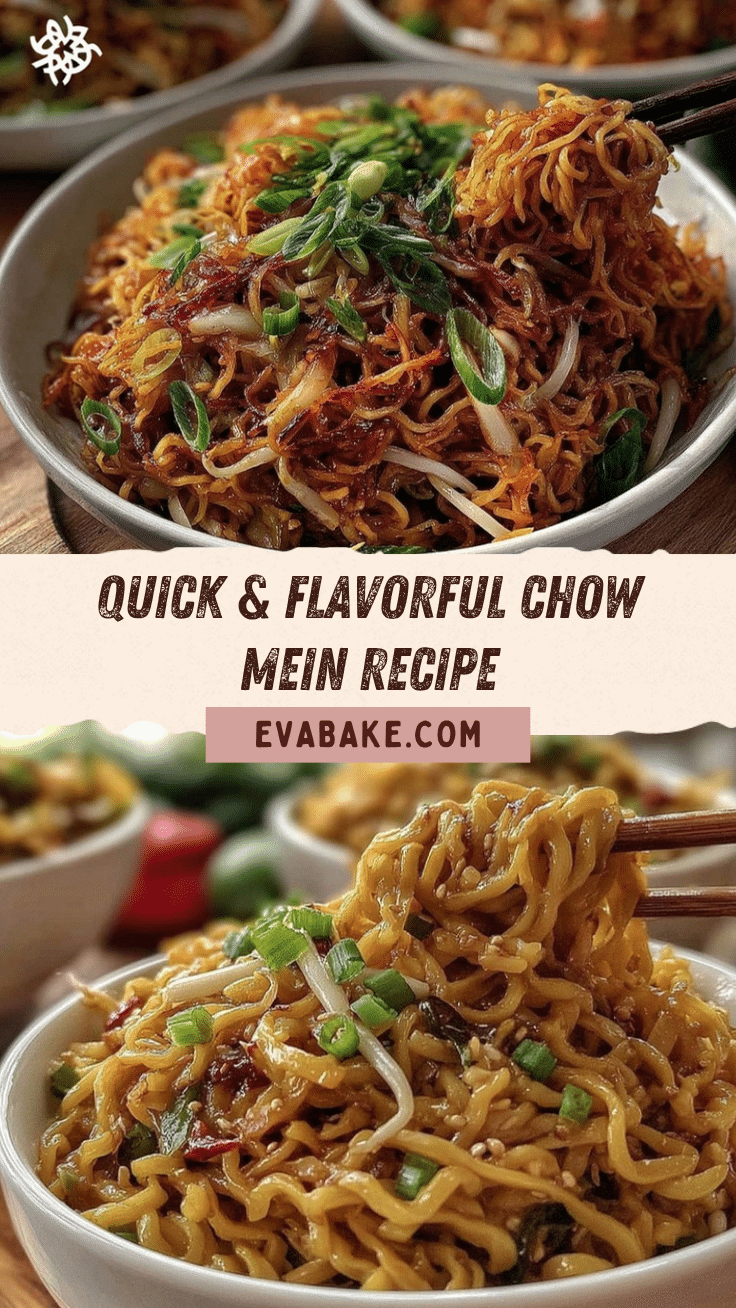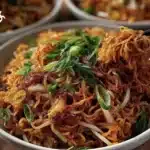The aroma of sizzling vegetables and savory noodles is enough to set your tastebuds dancing. Imagine this: a plate of perfectly cooked, golden noodles intertwined with vibrant pops of fresh veggies, tender protein, and a flavorful sauce that ties everything together beautifully. The first time I made this quick chow mein recipe, it was a rainy Saturday, and I was craving takeout but didn’t want to leave the comfort of my home. One bite in, and I knew I had discovered something magical—a dish that’s not only crazy delicious but also comes together faster than ordering delivery. This is the kind of recipe that makes you smile, knowing you’ve just unlocked the secret to making restaurant-quality Chinese food right in your own kitchen!
My family? Oh, they couldn’t get enough. I caught my husband sneaking bites straight from the pan—before I could even set the table. And let’s be real, I didn’t mind one bit (I did the same while cooking). If you’re looking for a recipe that’s simple, quick, and utterly satisfying, you’re in for a treat with this homemade chow mein recipe. Whether you’re planning a weeknight dinner or a special meal for friends, this dish is bound to become a staple in your rotation. Trust me, it’s that good!
Why You’ll Love This Recipe
- Quick & Easy: Ready in just 20 minutes, this chow mein recipe is perfect for busy weeknights or when you need a quick meal fix.
- Simple Ingredients: No need to hunt down specialty items—most ingredients are pantry staples or easily found at your local grocery store.
- Perfect for Any Occasion: Whether it’s a casual family dinner, meal prep for the week, or a dish to impress your friends, chow mein is always a hit.
- Crowd-Pleaser: Kids love its slurp-worthy noodles, and adults appreciate the fresh flavors. It’s a win-win!
- Unbelievably Delicious: The balance of savory soy sauce, sweet notes, and just a hint of sesame oil makes this dish addictive.
What makes this quick chow mein recipe stand out is the simplicity combined with bold flavors. The secret? A perfectly balanced sauce that’s not too salty, not too sweet, and coats every noodle like a dream. Plus, the fresh crunch of vegetables and tender bites of protein make this a dish that feels indulgent but is surprisingly light. It’s a meal that feels like comfort food but doesn’t weigh you down—ideal for when you want a satisfying meal without the guilt. You’re going to love how versatile it is—whether you stick to the classic recipe or make it your own with some fun variations!
What Ingredients You Will Need
This recipe uses simple, wholesome ingredients to deliver bold flavor and satisfying texture without the fuss. You might already have most of these items in your kitchen, and if not, they’re easy to find at the store.
For the Chow Mein Noodles
- 8 ounces chow mein noodles (or substitute with spaghetti or ramen noodles)
- 2 tablespoons sesame oil (adds a nutty flavor)
For the Vegetables

- 1 cup shredded cabbage
- 1 cup julienned carrots
- 1/2 cup sliced green onions
- 1 cup bean sprouts (optional, but adds great crunch)
For the Sauce
- 1/4 cup soy sauce (low-sodium works best)
- 2 tablespoons oyster sauce
- 1 tablespoon hoisin sauce (adds sweetness and depth)
- 1 teaspoon sugar (balances the flavors)
- 1/2 teaspoon sesame oil
For the Protein (Optional)
- 1 cup cooked chicken, shrimp, or tofu (or omit for a vegetarian option)
Feel free to mix and match the vegetables or proteins based on what you have on hand. Snap peas, bell peppers, or mushrooms work wonderfully, and you can substitute gluten-free tamari for soy sauce if needed.
Equipment Needed
- Large skillet or wok: A wok is ideal for stir-frying, but a large non-stick skillet works just as well.
- Pot: For boiling your noodles.
- Tongs or spatula: Essential for tossing the noodles and sauce together evenly.
- Cutting board: For prepping your veggies.
- Knife: A sharp chef’s knife makes quick work of julienning carrots and slicing cabbage.
If you’re just starting out, don’t worry about having a fancy wok. I’ve made this recipe countless times in a basic frying pan, and it still turns out delicious every time. If you’re using stainless steel, a little extra oil will prevent sticking.
Preparation Method
- Bring a pot of water to boil and cook the chow mein noodles according to package instructions (usually 3-4 minutes). Drain and toss with 1 tablespoon of sesame oil to prevent sticking. Set aside.
- In a small bowl, whisk together the soy sauce, oyster sauce, hoisin sauce, sugar, and sesame oil for the sauce. Set aside.
- Heat 1 tablespoon of sesame oil in a large skillet or wok over medium-high heat. Add the shredded cabbage, julienned carrots, and green onions. Stir-fry for 2-3 minutes until slightly softened.
- Add the cooked protein (if using) and continue to stir-fry for another 2 minutes until heated through.
- Reduce the heat to medium and add the cooked noodles to the skillet. Pour the prepared sauce over the noodles and toss everything together using tongs or a spatula. Cook for another 2-3 minutes until the noodles are coated evenly and heated through.
- Add bean sprouts (if using) and toss again. Cook for 1 minute to warm them slightly.
- Remove from heat and serve immediately. Garnish with additional green onions if desired.
It’s important to keep the heat at medium-high while stir-frying to ensure the vegetables stay crisp and the noodles don’t stick to the pan. If the sauce seems too thick, you can add a splash of water or chicken broth to loosen it up.
Cooking Tips & Techniques
- Don’t Overcook the Noodles: Follow the package instructions carefully and rinse the noodles under cold water after draining to stop the cooking process.
- Prep Ahead: Chop all your vegetables and whisk the sauce before you start cooking. Stir-frying happens fast, so having everything ready is key.
- Use High Heat: A hot skillet or wok ensures the vegetables stay crisp and the noodles don’t turn mushy.
- Customize the Sauce: Taste the sauce before adding it to the noodles. If you prefer it sweeter or saltier, adjust the sugar or soy sauce accordingly.
- Don’t Crowd the Pan: If your skillet feels too full, stir-fry the vegetables in batches to ensure everything cooks evenly.
Trust me, I’ve made the mistake of throwing everything into the pan at once, and it turned into a steamy mess. A little patience goes a long way!
Variations & Adaptations
- Vegetarian: Skip the chicken or shrimp and double up on the veggies. Add mushrooms, bell peppers, or snap peas for extra flavor.
- Gluten-Free: Use gluten-free tamari instead of soy sauce and swap the chow mein noodles for rice noodles.
- Low-Carb: Replace the noodles with spiralized zucchini or cabbage for a lighter option.
- Spicy Kick: Add a teaspoon of Sriracha or red pepper flakes to the sauce for some heat.
My personal favorite tweak? Tossing in some roasted peanuts or cashews at the end for a delightful crunch—it’s a game-changer!
Serving & Storage Suggestions
This chow mein is best served hot and fresh, straight from the skillet. Pair it with spring rolls, dumplings, or a side of steamed rice for a complete meal. For drinks, a chilled jasmine tea or sparkling water with lime complements the flavors beautifully.
To store leftovers, transfer the chow mein to an airtight container and keep in the refrigerator for up to 3 days. When reheating, use a skillet over medium heat and add a splash of water to revive the sauce. Avoid microwaving if possible—it can make the noodles rubbery.
Nutritional Information & Benefits
Per serving (based on four servings):
- Calories: 350
- Protein: 15g
- Carbohydrates: 45g
- Fat: 12g
- Fiber: 3g
The fresh vegetables bring a good dose of vitamins and fiber, while the protein keeps you full and satisfied. For those watching sodium, opt for low-sodium soy sauce. This dish is naturally dairy-free and can easily be made gluten-free.
Conclusion
If you’re looking for a quick, delicious, and customizable meal, this quick chow mein recipe is absolutely worth trying. It’s the kind of dish you’ll want to make again and again, tweaking it to suit your taste or to use up whatever veggies are hiding in your fridge.
Personally, this recipe holds a special place in my heart because it turns a simple weekday dinner into something extraordinary. I hope you love it as much as I do! Share your favorite variations in the comments below—let’s inspire each other to get creative in the kitchen. Happy cooking!
FAQs
Can I use spaghetti instead of chow mein noodles?
Yes, spaghetti works just fine as a substitute! Cook it al dente to mimic the texture of chow mein noodles.
Can I make this recipe ahead of time?
While chow mein is best served fresh, you can cook the noodles and prep the veggies ahead of time. Toss everything together right before serving.
What protein works best for chow mein?
Chicken, shrimp, and tofu are all great options. Leftover rotisserie chicken is a quick and easy addition!
Can I freeze chow mein?
Freezing is not recommended as the noodles tend to lose their texture. Stick to refrigerating leftovers for up to 3 days.
How can I make the dish spicier?
Add Sriracha, red pepper flakes, or diced chili peppers to the sauce for a spicy kick.
Pin This Recipe!

Quick Chow Mein Recipe Easy Homemade Chinese Food
A quick and easy chow mein recipe featuring golden noodles, fresh vegetables, tender protein, and a flavorful sauce that comes together faster than ordering takeout.
- Prep Time: 10 minutes
- Cook Time: 10 minutes
- Total Time: 20 minutes
- Yield: 4 servings 1x
- Category: Main Course
- Cuisine: Chinese
Ingredients
- 8 ounces chow mein noodles (or substitute with spaghetti or ramen noodles)
- 2 tablespoons sesame oil
- 1 cup shredded cabbage
- 1 cup julienned carrots
- 1/2 cup sliced green onions
- 1 cup bean sprouts (optional)
- 1/4 cup soy sauce (low-sodium works best)
- 2 tablespoons oyster sauce
- 1 tablespoon hoisin sauce
- 1 teaspoon sugar
- 1/2 teaspoon sesame oil
- 1 cup cooked chicken, shrimp, or tofu (optional)
Instructions
- Bring a pot of water to boil and cook the chow mein noodles according to package instructions (usually 3-4 minutes). Drain and toss with 1 tablespoon of sesame oil to prevent sticking. Set aside.
- In a small bowl, whisk together the soy sauce, oyster sauce, hoisin sauce, sugar, and sesame oil for the sauce. Set aside.
- Heat 1 tablespoon of sesame oil in a large skillet or wok over medium-high heat. Add the shredded cabbage, julienned carrots, and green onions. Stir-fry for 2-3 minutes until slightly softened.
- Add the cooked protein (if using) and continue to stir-fry for another 2 minutes until heated through.
- Reduce the heat to medium and add the cooked noodles to the skillet. Pour the prepared sauce over the noodles and toss everything together using tongs or a spatula. Cook for another 2-3 minutes until the noodles are coated evenly and heated through.
- Add bean sprouts (if using) and toss again. Cook for 1 minute to warm them slightly.
- Remove from heat and serve immediately. Garnish with additional green onions if desired.
Notes
Prep all vegetables and whisk the sauce before cooking to ensure smooth stir-frying. Adjust the sauce to taste and avoid overcrowding the pan for even cooking.
Nutrition
- Serving Size: 1 serving
- Calories: 350
- Fat: 12
- Carbohydrates: 45
- Fiber: 3
- Protein: 15
Keywords: chow mein, quick recipe, homemade Chinese food, stir-fry noodles, easy dinner, vegetarian option



